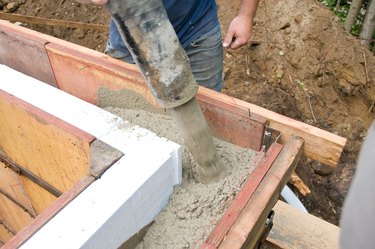
When foundation walls are not tall enough for a basement, they form a crawlspace. A crawlspace can be a couple of feet high or many feet high, depending upon building codes in your community. Even though you're not pouring an entire basement, you'll follow similar steps when constructing a crawlspace foundation. The location of your foundation on the lot, its elevation and your construction practices are all subject to local building codes.
Excavating the Foundation
Video of the Day
Technically, you could dig with shovels, but nearly all foundations today benefit from front-end loader and backhoe excavation. After staking out the foundation perimeter, the excavation contractor will dig the main foundation hole. At the bottom of the hole, he'll dig trenches for the footings. The depth of the crawlspace footings must be below the frost line for your geographical region, to prevent shifting of the foundation walls caused by soil expansion and contraction as moisture within the soil freezes and thaws.
Video of the Day
Pouring the Footings
Crawlspace walls require concrete footings that disperse the weight load of the house into the ground. Footings rest on virgin soil, meaning the footing trenches are dug only to the depth of the footing and no deeper. The soil beneath must be undisturbed. Building codes will determine the amount of steel reinforcement that you must use in the footings. While the concrete in the footing forms is still wet, you'll insert rebar poles into the footings. These poles provide vertical reinforcement that will tie the crawlspace walls to the footings.
Forming the Walls
Once the footings are in place, you can construct the wall forms. Local building codes regulate the thickness of the walls and the amount of steel reinforcement. Steel reinforcement usually takes the form of vertical rebar poles, intersected by horizontal rebar poles and tied together with rebar ties. Before you can pour the walls, the local building inspector will want to look at the project to ensure that you added enough steel and that your forms are strong enough to bear the weight of the wet concrete.
Pouring the Crawlspace Walls
The best way to pour the walls is in one continuous pour. Once you begin to dump the concrete, you should continue until all of the wall forms are full. This prevents cold joints that can occur when you pour only a portion of a wall and the concrete hardens before you add more. If you order more than one concrete truck, the concrete company will make sure any additional trucks needed are sitting at the curb, ready to pour as soon as the previous truck is empty.
Vibration and Anchor Bolts
While the concrete in the forms is wet, at least one worker should run a concrete vibrator to remove air bubbles that will weaken the concrete. Alternately, a worker can tap on the inside and the outside of the concrete forms with a rubber mallet to settle the concrete. When the concrete begins to thicken, you will insert anchor bolts into the top of the wall, leaving about 3 inches of the bolt above the level of the concrete. When you're ready to frame the house, the anchor bolts will secure the sill plate to the top of the crawlspace wall.